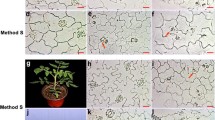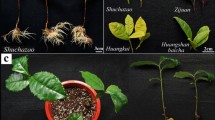Abstract
An effective protocol for protoplast isolation from young leaves and somatic embryogenic cells of species in the Chamelaucium group and the use of superoxide dismutase (SOD) and catalase (CAT) to enhance protoplast viability are described. Mesophyll protoplasts were isolated from young leaves of a white Geraldton waxflower (Chamelaucium uncinatum) line 583, using a mixture of 1% (w/v) cellulase R10, 0.5% (w/v) macerozyme R10, and 0.1% (w/v) pectolyase. Viability of isolated mesophyll protoplasts increased dramatically when SOD and CAT were added. The highest increase of 7.61-fold in viability and 4.34-fold of viable protoplast yield were achieved when a combination of SOD at 500 units mL−1 and CAT at 2,000 units mL−1 was added to the enzyme mixture. Somatic embryogenic cell-derived protoplasts were isolated from embryogenic suspension cells of C. uncinatum line 583 when 1% (w/v) hemicellulase was added to a combination of 2% (w/v) cellulase R10, and 1% (w/v) macerozyme R10. Addition of SOD at 500 units mL−1 and CAT at 2,000 units mL−1 to the enzyme mixture improved viability only slightly, to above 90%, but improved yield significantly (6.6-fold). This combination of enzymes was also used to isolate protoplasts from embryogenic suspension cells of Chamelaucium repens and from young leaves of C. uncinatum, Actinodium calocephalum, Verticordia etheliana, Verticordia grandis, Verticordia hughanii, and Verticordia mitchelliana successfully with viability >80% and viable yield >7 × 105 cells g−1 fresh weight (or per milliliter packed cell volume in the case of suspension cells).



Similar content being viewed by others
References
Barrett MD (2006) Molecular ecology of Chamelaucium uncinatum (Myrtaceae) and related species, and applications to plant breeding and conservation. Thesis. School of Plant Biology, The University of Western Australia, Crawley Western Australia, p 201
Bauer WD, Talmadge KW, Keegstra K, Albersheim P (1973) The structure of plant cell walls. Plant Physiol 51:174–187
Cutler A, Saleem M, Wang H (1991) Cereal protoplast recalcitrance. In Vitro Cell Dev Biol Plant 27:104–111
Dat J, Vandenabeele S, Vranová E, Van Montagu M, Inzé D, Van Breusegem F (2000) Dual action of the active oxygen species during plant stress responses. Cell Mol Life Sci 57:779–795
Feher A, Pasternak TP, Dudits D (2003) Transition of somatic plant cells to an embryogenic state. Plant Cell Tissue Organ Cult 74:201–228
Ishii S (1987) Generation of active oxygen species during enzymic isolation of protoplasts from oat leaves. In Vitro Cell Dev Biol Plant 23:653–658
Ishii S (1988) Factors influencing protoplast viability of suspension-cultured rice cells during isolation process. Plant Physiol 88:26–29
Kennedy B, De Filippis L (2004) Tissue degradation and enzymatic activity observed during protoplast isolation in two ornamental Grevillea species. In Vitro Cell Dev Biol Plant 40:119–125
Latif M (2003) Protocols. In: Department of Agriculture and Food WA (ed) Report for Horticulture division, South Perth WA, Australia
Latif M, Newell C, Growns D (2002) Using somatic hybridisation for resolving barriers to wide crossing in the Chamelaucium alliances. In: Taji A, Williams R (eds) Proceedings of the importance of plant tissue culture and biotechnology in plant sciences. New England Press, Armidale NSW, Australia
Murashige T, Skoog F (1962) A revised medium for rapid growth and bioassays with tobacco tissue cultures. Physiol Plant 15:473–497
Ohgawara T, Kobayashi S, Ishii S, Yoshinaga K, Oiyama I (1991) Fertile fruit trees obtained by somatic hybridization: navel orange (Citrus sinensis) and Troyer citrange (C. sinensis × Poncirus trifoliata). Theor App Genet 81:141–143
Papadakis AK, Roubelakis-Angelakis KA (1999) The generation of active oxygen species differs in tobacco and grapevine mesophyll protoplasts. Plant Physiol 121:197–206
Patat-Ochatt EM, Ochatt SJ, Power JB (1988) Plant regeneration from protoplasts of apple rootstocks and scion varieties. J Plant Physiol 133:460–465
Ratanasanobon K, Seaton K (2010) Development of in vitro plant regeneration of Australian native waxflowers (Chamelaucium spp.) via somatic embryogenesis. Plant Cell Tiss Organ Cult 100:59–64
Rezazadeh R, Williams RR, Harrison DK (2011) Factors affecting mango (Mangifera indica L.) protoplast isolation and culture. Sci Hortic 130:214–221
Rural Industries Research and Development Corporation (RIRDC) Overview of the wildflowers and native plants industry. In: Wildflowers and native plants R&D five year plan 2008–2013. Rural Industries Research and Development Corporation, Australian Government, Barton ACT, Australia, pp 7–11; 2008
Shan F, Seaton K (2009) Enhancing waxflower breeding efficiency through early embryo rescue. In: Geijskes JR, Lakshmanan P, Taji A (eds) Proceedings of the sixth international symposium on in vitro culture and horticultural breeding. ISHS, Brisbane Australia, pp 183–187
Tan MC, Boerrigter HS, Kool AJ (1987) A rapid procedure for plant regeneration from protoplasts isolated from suspension cultures and leaf mesophyll cells of wild Solanum species and Lycopersicon pennellii. Plant Sci 49:63–72
Thomas JR, McNeil M, Darvill AG, Albersheim P (1987) structure of plant cell walls. Plant Physiol 83:659–671
Wilder BM, Albersheim P (1973) The structure of plant cell walls. Plant Physiol 51:889–893
Acknowledgments
The research team thanks Horticulture Australia Limited (HAL) and the Department of Agriculture and Food Western Australia for funding and supporting this project. The authors thank Mr. Christopher McMullan for maintaining plant material.
Author information
Authors and Affiliations
Corresponding author
Additional information
Editor: J. Forster
Rights and permissions
About this article
Cite this article
Ratanasanobon, K., Seaton, K.A. Protoplast isolation for species in the Chamelaucium group and the effect of antioxidant enzymes (superoxide dismutase and catalase) on protoplast viability. In Vitro Cell.Dev.Biol.-Plant 49, 593–598 (2013). https://doi.org/10.1007/s11627-013-9527-7
Received:
Accepted:
Published:
Issue Date:
DOI: https://doi.org/10.1007/s11627-013-9527-7




